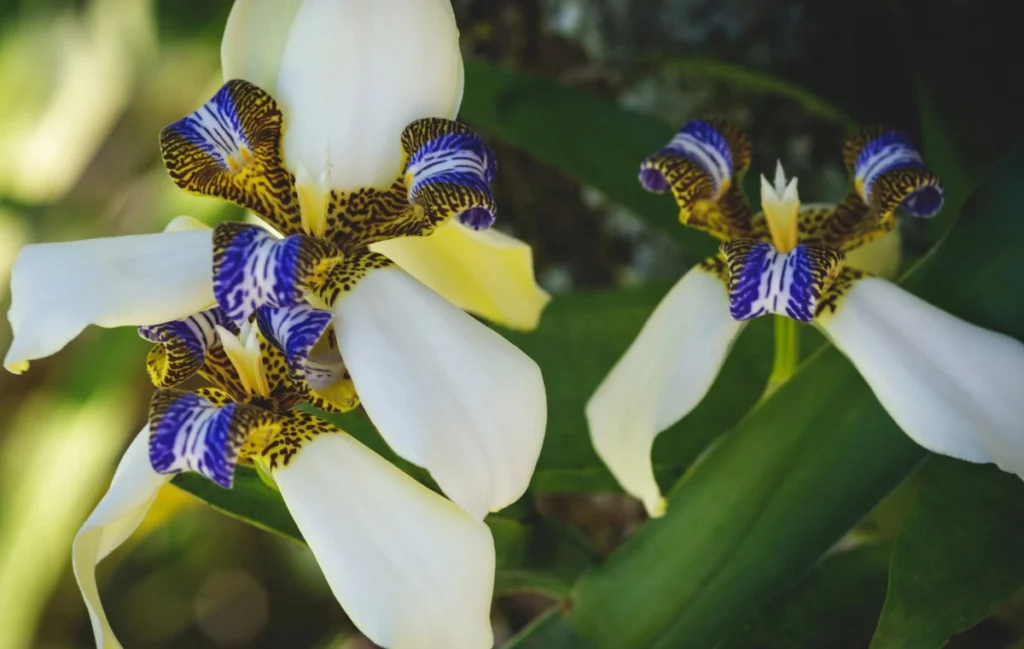The Walking Iris (Neomarica candida) is a rhizomatous, herbaceous plant known for its decorative foliage and flowering. Native to South America, from countries such as Paraguay, Uruguay, Argentina, and Brazil, this species is widely recognized for its ornamental beauty and resilience.
The genus name Neomarica derives from the Greek “neo,” meaning new, and “marica,” a nymph from Roman mythology married to Faunus and venerated in the Minturno woods, a small town south of Rome. An old legend says that the plant, when propagated by seeds, only blooms after the emergence of twelve leaves, representing the apostles of Jesus Christ, which also gives it the popular name Apostle Plant. The specific epithet candida comes from Latin, referring to the white petals of the species’ flowers.

The Walking Iris is native to the coastal sand dunes of South America, adapting well to coastal environments due to its tolerance to salinity and sea winds. In its natural habitat, it grows in well-drained soils, rich in organic matter, and often covered by a thick layer of forest debris composed of leaves and branches in various stages of decomposition (leaf litter).
Neomarica candida is a perennial herbaceous plant that can reach up to 35 inches (90 cm) in height. Its leaves are bright green, glabrous, and blade-like, arranged in a fan shape, giving the plant a full and clustered appearance over time. The inflorescences emerge in spring and summer, with erect stems that bear delicate and ephemeral flowers. Each flower has three horizontal white sepals with brown streaks at the base and three blue recurved petals. Due to these different and exotic petals, the flowers are often mistaken for orchids.
An interesting fact about the Walking Iris is that its flowers are visited by butterflies, attracted by the color and shape of the petals. Additionally, the plant has a continuous flowering cycle in tropical and warm climates, reducing flowering in regions with colder winters.
The flowers of the Walking Iris last only one day, opening at dawn and wilting by dusk. After flowering, the flower stems bend until they touch the ground, where they root and form new plants, a characteristic that gives rise to the popular name “Walking Iris.”
In landscaping, the Walking Iris is a recurring choice because it is hardy, requiring little or no maintenance, in addition to being perennial and highly ornamental. Even when not in bloom, its shiny leaves and full, clustered texture beautify gardens. It can be used in mass plantings and borders, preferably in partial shade, at the edges of woods, preferably in areas receiving filtered light from tree canopies, but it can also be planted in pots and planters. Moreover, it is an excellent option for beach gardens due to its tolerance to salinity and coastal winds.

The Walking Iris should be cultivated in full sun, partial shade, or light shade, in fertile soil, enriched with organic matter and well-drained. The plant appreciates tropical humidity and blooms best when it receives direct sunlight for a few hours a day. The absence of flowers occasionally may often be related to insufficient light, due to excessive shading. It is resistant to cold and light frosts.
During planting or replanting, it is important not to bury the rhizomes deeply, as this can cause diseases and reduce flower production. Apply a good layer of mulch over the soil of the beds, which helps maintain temperature and moisture. Fertilize with organic fertilizers during spring and summer. Propagation can be done by seeds, but more easily by division of the rhizomes, clumps, or by separating the plantlets that form on the flower stems.


